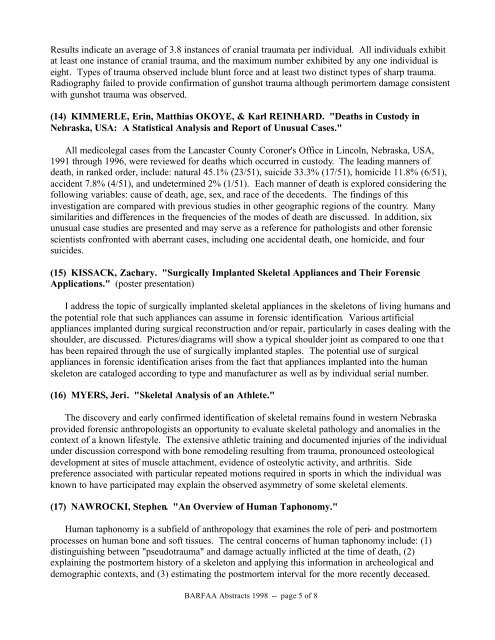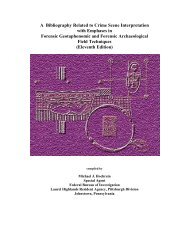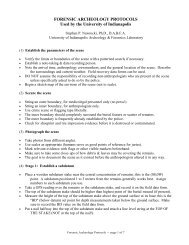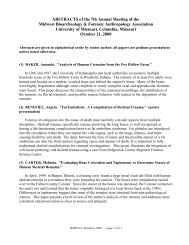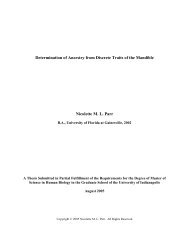ABSTRACTS of the 5th Annual Meeting of the Midwest ...
ABSTRACTS of the 5th Annual Meeting of the Midwest ...
ABSTRACTS of the 5th Annual Meeting of the Midwest ...
You also want an ePaper? Increase the reach of your titles
YUMPU automatically turns print PDFs into web optimized ePapers that Google loves.
Results indicate an average <strong>of</strong> 3.8 instances <strong>of</strong> cranial traumata per individual. All individuals exhibitat least one instance <strong>of</strong> cranial trauma, and <strong>the</strong> maximum number exhibited by any one individual iseight. Types <strong>of</strong> trauma observed include blunt force and at least two distinct types <strong>of</strong> sharp trauma.Radiography failed to provide confirmation <strong>of</strong> gunshot trauma although perimortem damage consistentwith gunshot trauma was observed.(14) KIMMERLE, Erin, Matthias OKOYE, & Karl REINHARD. "Deaths in Custody inNebraska, USA: A Statistical Analysis and Report <strong>of</strong> Unusual Cases."All medicolegal cases from <strong>the</strong> Lancaster County Coroner's Office in Lincoln, Nebraska, USA,1991 through 1996, were reviewed for deaths which occurred in custody. The leading manners <strong>of</strong>death, in ranked order, include: natural 45.1% (23/51), suicide 33.3% (17/51), homicide 11.8% (6/51),accident 7.8% (4/51), and undetermined 2% (1/51). Each manner <strong>of</strong> death is explored considering <strong>the</strong>following variables: cause <strong>of</strong> death, age, sex, and race <strong>of</strong> <strong>the</strong> decedents. The findings <strong>of</strong> thisinvestigation are compared with previous studies in o<strong>the</strong>r geographic regions <strong>of</strong> <strong>the</strong> country. Manysimilarities and differences in <strong>the</strong> frequencies <strong>of</strong> <strong>the</strong> modes <strong>of</strong> death are discussed. In addition, sixunusual case studies are presented and may serve as a reference for pathologists and o<strong>the</strong>r forensicscientists confronted with aberrant cases, including one accidental death, one homicide, and foursuicides.(15) KISSACK, Zachary. "Surgically Implanted Skeletal Appliances and Their ForensicApplications." (poster presentation)I address <strong>the</strong> topic <strong>of</strong> surgically implanted skeletal appliances in <strong>the</strong> skeletons <strong>of</strong> living humans and<strong>the</strong> potential role that such appliances can assume in forensic identification. Various artificialappliances implanted during surgical reconstruction and/or repair, particularly in cases dealing with <strong>the</strong>shoulder, are discussed. Pictures/diagrams will show a typical shoulder joint as compared to one thathas been repaired through <strong>the</strong> use <strong>of</strong> surgically implanted staples. The potential use <strong>of</strong> surgicalappliances in forensic identification arises from <strong>the</strong> fact that appliances implanted into <strong>the</strong> humanskeleton are cataloged according to type and manufacturer as well as by individual serial number.(16) MYERS, Jeri. "Skeletal Analysis <strong>of</strong> an Athlete."The discovery and early confirmed identification <strong>of</strong> skeletal remains found in western Nebraskaprovided forensic anthropologists an opportunity to evaluate skeletal pathology and anomalies in <strong>the</strong>context <strong>of</strong> a known lifestyle. The extensive athletic training and documented injuries <strong>of</strong> <strong>the</strong> individualunder discussion correspond with bone remodeling resulting from trauma, pronounced osteologicaldevelopment at sites <strong>of</strong> muscle attachment, evidence <strong>of</strong> osteolytic activity, and arthritis. Sidepreference associated with particular repeated motions required in sports in which <strong>the</strong> individual wasknown to have participated may explain <strong>the</strong> observed asymmetry <strong>of</strong> some skeletal elements.(17) NAWROCKI, Stephen. "An Overview <strong>of</strong> Human Taphonomy."Human taphonomy is a subfield <strong>of</strong> anthropology that examines <strong>the</strong> role <strong>of</strong> peri- and postmortemprocesses on human bone and s<strong>of</strong>t tissues. The central concerns <strong>of</strong> human taphonomy include: (1)distinguishing between "pseudotrauma" and damage actually inflicted at <strong>the</strong> time <strong>of</strong> death, (2)explaining <strong>the</strong> postmortem history <strong>of</strong> a skeleton and applying this information in archeological anddemographic contexts, and (3) estimating <strong>the</strong> postmortem interval for <strong>the</strong> more recently deceased.BARFAA Abstracts 1998 -- page 5 <strong>of</strong> 8


